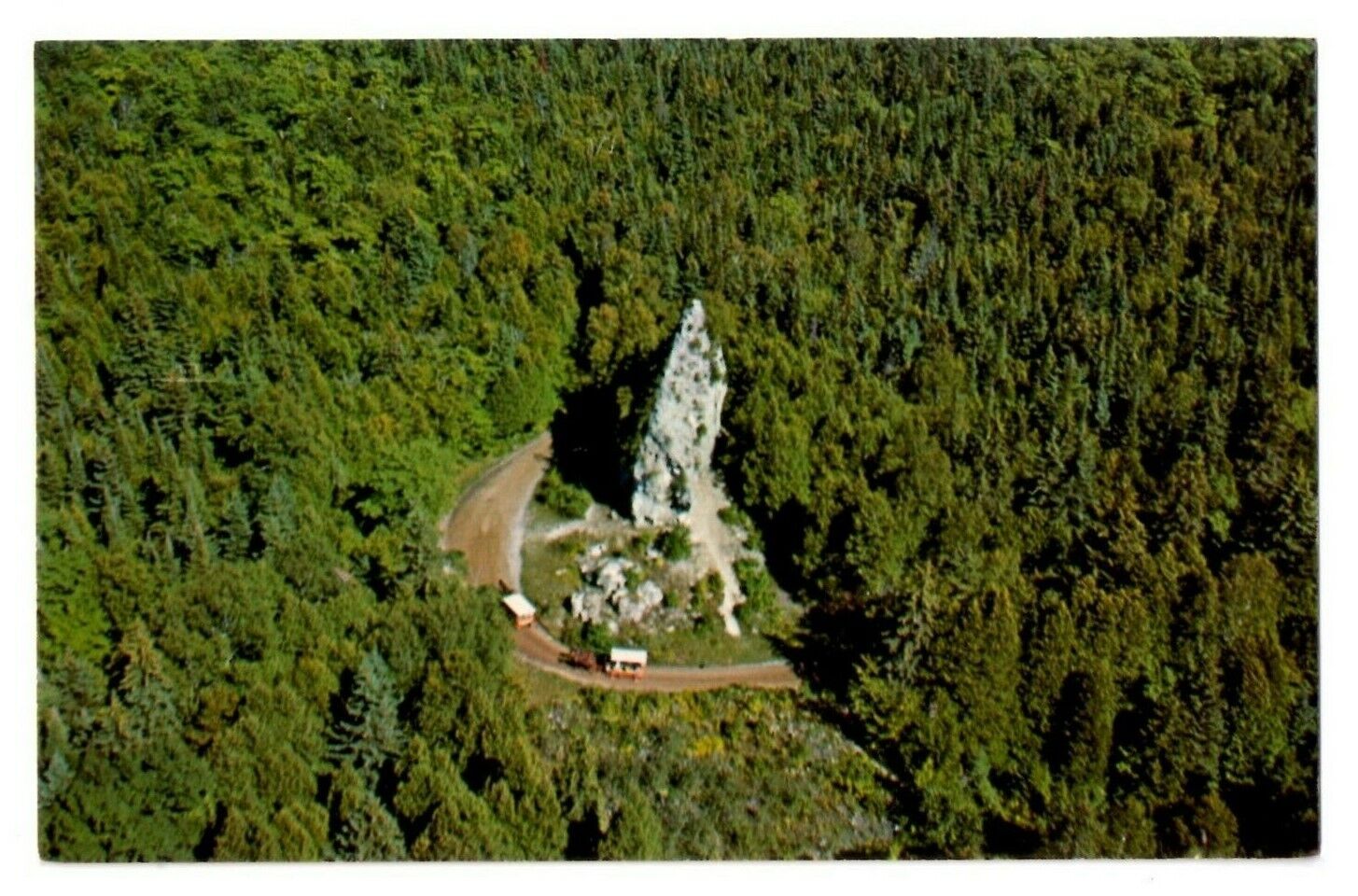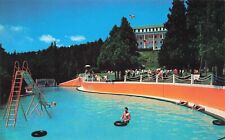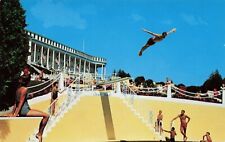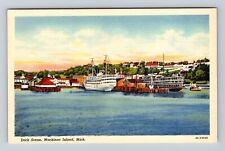Mackinac Island, Michigan (Sugar Loaf Tourist Site) 1963 Photo Postcard UnPosted For Sale

When you click on links to various merchants on this site and make a purchase, this can result in this site earning a commission. Affiliate programs and affiliations include, but are not limited to, the eBay Partner Network.
Mackinac Island, Michigan (Sugar Loaf Tourist Site) 1963 Photo Postcard UnPosted:
$34.99
SKU: A1-(0032) Have A Question? Please Message Us! We are more than happy to help.Mackinac Island, Michigan (Sugar Loaf Tourist Site) 1963 Photo Postcard Un-Posted
Sugar Loaf via WikipediaSugar Loaf is a 75-foot-high (23m) landlocked rock or stack in the interior of Mackinac Island in Lake Huron. Created by erosion during the period of postglacial Lake Algonquin, Sugar Loaf is the largest post-glacial erosion feature in the Straits of Mackinac. The immense rock, which consists of resistant limestone breccia, was cut off from Ancient Mackinac Island or the Turtle\'s Back by the glacial meltwaters of Lake Algonquin. Polar storms released by the retreating ice sheet created erosional forces much stronger than any existing today on the Great Lakes. The rock lies within the boundaries of the Mackinac Island State Park near the junction of Crooked Tree Road and Sugar Loaf Road. It can be seen from Point Lookout, near the Island\'s highest point.
A wide variety of stories were told by Native Americans and frontier dwellers about Sugar Loaf. It was said by some to be the home of Gitchie Manitou. Other tales suggested that the rock was the final form taken by a man afflicted with hubris who broke a taboo and was punished by being petrified into the form of a giant stone. The profile in limestone, affixed to the side of Sugar Loaf Rock, of a male face may have suggested this legend. The profile is said to be that of the lost soul, who can never escape the identity he took upon his moral condemnation.
Sugar Loaf Rock appears to have been used as a site of ritual burials and inhumations. In 1831, Alexis de Tocqueville and his friend Gustave de Beaumont visited Mackinac Island. De Beaumont reported that the rock was filled with \"crevices and faults where the Indians sometimes deposed the bones of the dead.\" Any such deposits have long since disappeared.
A natural cave passes through Sugar Loaf from side to side, too small for passage by any other than adventurous children.
Product Description: Mackinac Island, Michigan (Sugar Loaf Tourist Site) 1963 Photo Postcard Un-Posted
This is an original1963 postcardprint from a realaerial photograph takensometime after the start of Carriage Tours. The ban of automobiles on the island in 1901 resulted in the creation of horse and buggy sightseeing rides. After WWII ended, Stewart Woodfill, owner of the Grand Hotel, began the promotion “Horse is King,” and then in 1948 Mackinac Island Carriage Tours was formally Photograph Postcard
Size: 3.5 x 5.5 (9 x 14 cm)Condition: Above average. Card has very minimal age related wear. View photos for details.Publisher: The L. L. Cook Co.Category: Un-postedPostmark: N/ACopyright: Original 1963For sell is an original vintage postcard as shown above. Please view images of the item to determine it\'s condition.
Cards from all eras are popular as they often contain images of cars, stores, and places that people may recognize. All cardsand photos are shipped within a protective folded card which is all contained inside a first class envelope.
There are popular postcard collecting topics. Don\'t limit yourself to those topics, just collect anything that interests you. There are postcards for any taste or budget. Many people collect topics related to their profession and/or other hobbies.
We are a U.S. seller. This product is in stock and ready to ship.
- Advertising postcard. - A postcard that advertises a product, service, or event.
- Advertising trade card. - A card that advertises something, but is not a postcard.
- Antique postcard. - Usually refers to a postcard published before 1920.
- Artist-signed. - The artist\'s signature appears on the postcard illustration.
- Chrome. - A printed glossy-surface postcard that was based on a color photo.
- Comic. - A humorous postcard.
- Continental size. - Size is approximately 4 X 6 inches.
- Deltiology. - The hobby of postcard collecting.
- Divided back. - Card back is divided into a message space on the left and an address space on the right, allowed in the U.S. since 1907.
- Embossed. - The card design is printed so it is raised above the surface.
- Exaggeration. - Part of the image is exaggerated by scaling it much larger than the rest of the image.
- Exposition. - Usually an official World\'s Fair, but there are also smaller regional fairs called expositions.
- Folder. - Reproductions of postcard views (about 12 to 18) printed on both sides of a long strip of paper that folds up into an attached wrapper.
- Golden Age. - Period during early 1900s before World War I when postcard collecting was very popular.
- Greetings. - Greeting cards printed as postcards for birthdays, holidays, friendship, etc.
- Heavily embossed. - Degree of embossing is greater than average and colors appear to be airbrushed rather than printed realistically. Sometimes they will have a flat paper backing.
- Hold-to light. - Usually means multi-layered postcards with parts of the top layer cut out. When the card is held to the light, the cut-out areas (such as a windows, lights, sun, or moon) appear illuminated. Another type has oiled sections that transmit the light.
- Installment set. - A set of individual postcards that form a larger picture when placed side by side.
- Large letter. - Outlines of large-lettered place names are filled with images.
- Linen. - Postcards printed on paper with a linen-textured surface.
- Linen era. - Early 1930s to early 1950s.
- Lot. - Multiple postcards offered for sale as a group.
- Mail art. - Art exchanged through the mail - includes postcards, faux postage, etc.
- Maximum card. - A postage stamp with an appropriate cancellation placed on the picture side of a postcard having a similar image (maximum concurrence of postcard, stamp, and postmark).
- Modern era. - Mid 1970s or later, usually continental size.
- Multi-view. - A card with multiple pictures.
- Name band. - Card with multiple picture areas separated by a solid color band printed with a location name.
- Novelty. - Postcard made of unusual materials or having an unusual shape.
- Old postcard. - Can mean any card that is not new, but more often means cards from the 1920s or earlier.
- Oversized. - Length of the card is greater than 6 inches.
- Pioneer. - Card produced before the Private Mailing Card Act of 1898.
- Postal card. - A card with preprinted postage supplied by the U.S. Postal Service.
- Private Mailing Card. - The term \"Private Mailing Card\" was printed on the address side of privately produced postal cards between 1898 and 1901.
- Rack cards. - Modern advertising postcards distributed free on racks.
- Real photo. - A photographic image printed on photographic paper with a postcard back. Images printed on cardstock by a printing press are not real photos.
- Series. - A group of cards published on a particular subject and having a similar design. Often, but not always, has the word series on the back.
- Stamp box. - A printed rectangular box in the upper right corner of the postcard back that indicates where the postage stamp should be placed.
- Standard size. - Postcard measuring 3½ X 5½ inches.
- Tinsel. - Substance similar to glitter that was used to decorate postcards.
- Topical. - A card that fits into a specific subject category.
- Topographical. - Same as a view card.
- Undivided back. - Postcard published before 1907 when only the address was allowed on the back of the card.
- View cards. - Cards based on realistic images of specific locations.
- Vintage. - Usually refers to cards from the 1930s through the 1960s, but could mean any card at least twenty-five years old.
Postcard types and eras - Postcards are frequently classified by the era in which they were produced. The following descriptions of five eras refer to cards made in, or especially for, the United States market. There are also some earlier and less common \"pioneer\" era postcards.
Early Twentieth Century - The Golden Age of postcards lasted from the beginning of the century until about 1914. Before World War I, most of the better quality cards were printed in Europe. Postcards were very popular as collectibles, and many were saved. Printing was usually high quality, though many of the comics are cheap looking. Greeting cards are colorful and usually embossed. View cards usually have good detail, deep colors, and no border. Most view cards are based on black-and-white photos with color added. Real photo cards printed on photo paper were made in limited quantities on a wide variety of local subjects. Studio portraits and family snapshots were also often printed as postcards. White Border - White border postcards were produced mainly from about 1914 to 1932. View cards usually have white borders and paler colors than earlier postcards. The printing is usually not as good as that on earlier cards. Paper stock is usually coated and has a flat non-glossy surface. Most of the cards from this era are views. Greeting postcards were less common and usually were not embossed.Note: Some newer postcards have white borders, but they are not considered \"white border\" postcards.Linen - From 1933 until the early 1950s most U.S. views and comics were printed on card stock with a linen texture. Advertising, large-letter, expositions, and comics from this era are usually colorful and attractive. In my opinion, the view cards from this era are less attractive than earlier or later cards. Real photos of tourist areas were also fairly common in this era. The real photos cards from this era are generally glossier and more contrasty than earlier ones and have titles in white letters near the bottom of the picture.Standard/Chrome - Chrome cards have a glossy surface and are based on color photos. This type of postcard was produced as early as 1939, but was not common until the mid-1950s. Until the mid-1970s most U.S. cards were the \"standard\" size, approximately 3-1/2 X 5-1/2 inches.Continental/Modern - \"Continental\" size is approximately 4 X 6 inches. This size was common in Europe earlier than in the U.S. Most of the cards sold in the U.S. since the mid-1970s are this size. View cards are relatively fewer and more generic than in earlier eras. A large variety of subjects have been produced on modern cards aimed at collectors. These include both individual cards and many books of removable postcards. Holiday greeting postcards are available but not very common. They were more common in the 1980s than they are now.Super-sized postcards approximately 5\" X 7\" have been appearing more recently. These are smaller than most of the over-sized cards of the past, but are too large to mail at the regular postcard rate (maximum size: 6 inches long by 4-1/4 inches high).*** Please make sure shipping address is correct when checking out, as the address cannot be changed after order is placed.
We want you to be happy with your purchase. You may return items only in the original condition within 30 days.
Thank You For Shopping!

Related Items:
Esther Williams Swimming Pool, Grand Hotel Mackinac Island Michigan Vintage PC
$29.99
Beautiful Dive into Serpentine Pool, Grand Hotel Mackinac Island Michigan
$19.99
Mackinac Island MI-Michigan, Dock Scene, Antique, Vintage Souvenir Postcard
$6.99



